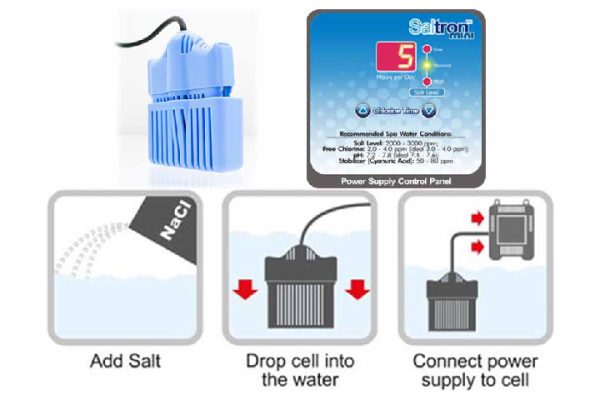Keeping your spa clean and safe for users is essential, but traditional sanitation methods can be cumbersome, costly, and may involve harsh chemicals. The Saltron Mini Chlorine Generator, specifically designed for spas, offers an innovative solution for spa sanitation. In this article, we’ll discuss the benefits of the Saltron Mini Chlorine Generator and how it’s changing the game in spa sanitation. Additionally, we’ll delve into the advantages of a saltwater spa and why it might be the perfect choice for your home.
- Saltron Mini Chlorine Generator: An Overview
The Saltron Mini Chlorine Generator is a compact, easy-to-use sanitation system designed for use in spas and hot tubs. It works by converting salt into chlorine, maintaining the ideal sanitizer levels to keep your spa clean, clear, and safe for use. The Saltron Mini eliminates the need for traditional chlorine tablets, resulting in a more convenient and eco-friendly spa sanitation method.
- Why the Saltron Mini Chlorine Generator Is a Game Changer
There are several reasons why the Saltron Mini Chlorine Generator is revolutionizing spa sanitation:
- Reduced chemical usage: By producing its own chlorine from salt, the Saltron Mini significantly reduces the need for traditional chlorine tablets, which can be harsh on both the environment and the spa users.
- Cost-effective: Since the Saltron Mini generates chlorine from salt, you’ll save money on purchasing traditional chemicals and tablets.
- Easy maintenance: The Saltron Mini features a self-cleaning cell, reducing the time and effort spent on spa maintenance.
- Improved water quality: Saltwater spas are known for their silky, soft water, which can be more pleasant for users and easier on the skin, eyes, and hair.
- The Benefits of a Salt Water Spa
A saltwater spa offers numerous benefits that set it apart from traditional chemically sanitized spas:
- Enhanced bather comfort: Saltwater is gentler on the skin, eyes, and hair, providing a more comfortable and enjoyable spa experience.
- Low maintenance: A saltwater system requires less frequent monitoring and adjusting of sanitizer levels, making maintenance less time-consuming and stressful.
- Environmentally friendly: The reduced reliance on traditional chlorine tablets is better for the environment, as the production of these tablets can be energy-intensive and create waste.
- Cost savings: Over time, the cost savings from not having to purchase traditional chlorine tablets can offset the initial investment in a saltwater system.
- Making the Switch to a Saltron Mini Chlorine Generator and Salt Water Spa
Switching to a Saltron Mini Chlorine Generator and a saltwater spa is a straightforward process:
- Purchase a Saltron Mini Chlorine Generator that is compatible with your spa’s size and specifications.
- Add the recommended amount of salt to your spa water according to the Saltron Mini instructions.
- Install the Saltron Mini following the manufacturer’s guidelines, ensuring that it is securely connected to your spa’s power source and plumbing.
- Monitor and adjust your spa’s water chemistry as needed, maintaining proper pH and alkalinity levels to ensure optimal performance and longevity of your Saltron Mini and saltwater system.
Conclusion:
The Saltron Mini Chlorine Generator is a groundbreaking innovation in spa sanitation, offering a more convenient, cost-effective, and environmentally friendly solution for maintaining clean and safe spa water. With the added benefits of a saltwater spa, including improved bather comfort and reduced maintenance requirements, there’s no better time to consider making the switch to a Saltron Mini Chlorine Generator and experiencing the difference for yourself. Share this knowledge with fellow spa owners and spread the word about this revolutionary approach to spa sanitation.
